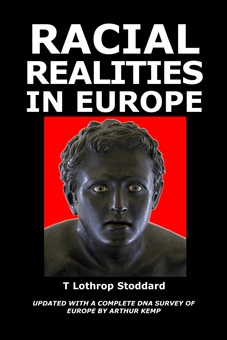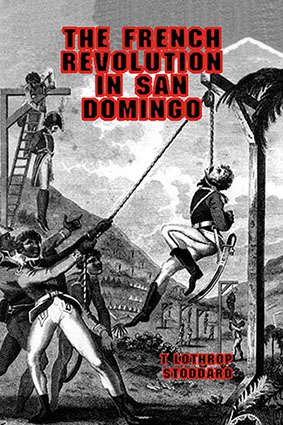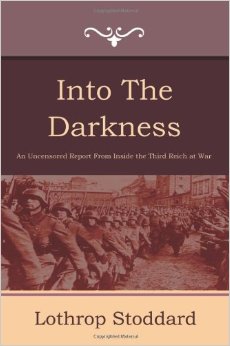jeudi, 01 janvier 2015
Guillaume Faye: Sex and Deviance

Guillaume Faye: Sex and Deviance
Sex and Deviance is at once a raging critique of the values underpinning contemporary Western societies and a down-to-earth, pragmatic vision of the future. Guillaume Faye is meticulous in his analysis of the points at which Western societies have deviated from their golden mean, thus having triggered the tidal wave of social ills that they are facing and can expect to face. Faye identifies at the centre of this vortex the matter of sex and sexuality, and with this proffers an answer to the perennial question: What is the glue that holds societies together?
Faye’s penetrating assault on the specious thinking of ideologues is certain to rattle the convictions of those from across the spectrum. Much more than just a socio-political exposition, this book is an invitation to shed old ways of thinking and to begin new, hard-headed discussion over the most pertinent issues of this century.
To order the book (19 £):
http://www.arktos.com/guillaume-faye-sex-and-deviance-softcover.html

Introduction
1. Funeral Dirge for the Family
The Disappearance of the Lasting Couple
Fragility of Unions Based on Romantic Love
The Politisation of Love: Symptom of Neo-Totalitarianism
Love is Not a Gift, but a Calculation
The Decline of the Duty to Continue the Lineage
Supremacy of the Anti-Familial Ideology
Consequences of the Deterioration of the Monogamous Couple
The Destruction of the Bourgeois Family Results in Chaos
Polyamory, Polygamy, Polyfidelity: Toward Involution
Spoiled Child, Sick Child

2. The Sacralisation of Homosexuality
Homophile Ideology and the ‘Struggle against Homophobia’
The Pathology of Homosexual Discourse and the Homosexual Mentality
The Egoism, Egotism, and Superficiality of ‘Gay Culture’
Proselytising the Gay Religion
Psychopathology and Fraud of the Male Homosexual Couple
The Psychology of Homosexuality
The Real Aim of the Fight against Homophobia
Are Gays Really...Gay?
The Innocence of Lesbians: Female Homosexuality
Are We All Bisexual?
The Delirium of Homoparentality
Homophobia among ‘Youths’
Gender Theory: The Latest Whim of Homosexualist and Feminist Ideology
3. Males and Females: Complex Differences
Woman’s Deep Psychology and Archetypical Representations
Questions about the Dependence and Submission of Women
Questions on Male Superiority and the ‘Dominant Male’
Effeminisation and Devirilisation of Society
Different Ways the Sex Act Is Perceived Between Men and Women
The Rising Power of Women Today
Women’s Revenge and the Possible Reversal of Sexual Polarity
The Unisex Utopia
The Dialectics of Double Domination
Love, Money, and Interest
4. Feminist Schizophrenia
The Insurmountable Contradictions of Feminism
The Two Feminisms: Sane and Insane
The Androgynous Utopia
The Dogma of ‘Parity’
Feminism and Careerism
The Feminisation of Values
5. The Farce of Sexual Liberation
An Ideology of Puritans
The False Promises of Sexual Liberation
The Illusion of Virtual Encounters
6. Sex and Perversions
Sexual Obsession and Sexual Impoverishment
Asexuals and the Extinction of Desire: Fruits of Hypersexualism
Immodesty as Anti-Eroticism
The Sexual Destructuration of Adolescents
Rapes, Sex Crimes, and Judicial Laxity
The Explosion in Sexual Violence by Minors
Violence and Sexism at School
Minors Having Abortions
Female Victims of Violence: Organised Dishonesty
The Suffering of Women in Immigrant Neighbourhoods
To Be a Homophobe is Prohibited; To Be a Paedophile is Permissible
7. Ineradicable Prostitution
Prostitution and Polytheistic Cults
Explosion and Polymorphism of Prostitution
Barter Prostitution
Regulating Prostitution
8. Sex and Origin
The Pressure for ‘Mixed’ Couples and Unions
The Race-Mixing Imperative, Soft Genocide, and Preparing the Way for Ethnic Chaos
Miscegenation as Official State Doctrine
Different Sexualities
Sexual Violence and Sexual Racism
Sexual Ethnomasochism and Divirlisation
Birthrates and Ethnic Origin
 9. Islam and Sex
9. Islam and Sex
The Contradiction of Sexual Permissiveness in the Face of Islam
Macho Nervous Schizophrenia
Misogyny and Gynophobia
10. Christianity and Sex
The Canonical Sexual Morality of the Church
Failure of the Sexual and Conjugal Morality of the Church
Christian Sex-Phobia Has Provoked Sex-Mania by way of Reaction
From Sexual Sin to the Sin of Racism
11. Sex, Biotechnology, and Biopolitics
Improbable Human Nature
Biotechnology and Evolution
Rearguard Actions Against Biotechnology
What the Future May Have in Store
Conclusion
Appendix A
Appendix B
Appendix C
Appendix D
Appendix E
Appendix F
Appendix G
Index
Guillaume Faye was one of the principal members of the famed French New Right organisation GRECE in the 1970s and '80s. After departing in 1986 due to his disagreement with its strategy, he had a successful career on French television and radio before returning to the stage of political philosophy as a powerful alternative voice with the publication of Archeofuturism. Since then he has continued to challenge the status quo within the Right in his writings, earning him both the admiration and disdain of his colleagues. Arktos has also published English translations of his books Archeofuturism (2010), Why We Fight (2011), and The Convergence of Catastrophes (2012).
00:05 Publié dans Livre, Livre, Nouvelle Droite, Synergies européennes | Lien permanent | Commentaires (0) | Tags : sexualité, nouvelle droite, guillaume faye, livre, synergies européennes |  |
|  del.icio.us |
del.icio.us |  |
|  Digg |
Digg | ![]() Facebook
Facebook
Theodore Lothrop Stoddard

Remembering Theodore Lothrop Stoddard (29 June 1883 - 1 May 1950)
Alex Kurtagic
Ex: http://www.wermodandwermod.com
American historian, journalist, anthropologist, and eugenicist Theodore Lothrop Stoddard was born 131 years ago today. A popular author and journalist until World War II, he was the author of 18 books, most published by a prestigious New York Publisher, Charles Scribner, including, The French Revolution in San Domingo (1914) and The Revolt Against Civilization (1922), of which we published new, annotated editions in 2011.
 Stoddard was the archetypical product of ivy-league education in the old United States. He graduated magna cum laude from Harvard University, studied law at Boston University, and obtained a PhD in history from Harvard University, later published as the aforementioned book on San Domingo (Haiti).
Stoddard was the archetypical product of ivy-league education in the old United States. He graduated magna cum laude from Harvard University, studied law at Boston University, and obtained a PhD in history from Harvard University, later published as the aforementioned book on San Domingo (Haiti).
Stoddard was closely associated with Madison Grant's circle of eugenicists and immigration restrictionists during the early part of the 20th century. His work, like that of his colleagues, is controversial today, and books like The Rising Tide of Colour (1920) set forth theses which would be rejected out of hand by present-day policy makers, even though said theses, if at times expressed in a language we would no longer use, have proven broadly correct, with the collapse of the European empires, the demographic trends of the past fifty years in Europe and North America due to mass immigration, the rise of Japan, and the rise of Islam as a threat to the West due to regious fanaticism. He also predicted a second world war and a war between Japan and the United States. Indeed, in his day, Stoddard's influence was significant, to the point of being alluded to in F. Scott Fitzgerald's The Great Gatsby. As is typical of American writers, then and now, and from all sides of the American political spectrum, Stoddard was accutely focused on human races, their characteristics, their relative status, and the conflicts of interests arising between them. As a representative of the old WASP establishment in his country, he was also preoccupied its continuity.
 But, while socially conservative, he was in every other sense a progressive liberal, strange as that may seem today: for him, eugenics was about improving the efficiency of human society—an aspiration well in keeping with the ideals of the Progressive Age in America, which was all about efficiency, wholesomeness, and purification (something not unrelated to Protestant ideals), and well in keeping with today's progressives, even if their approach is very different. Indeed, eugenics at this time (which was a generation or more before it fell into disrepute) was seen by its proponents as humane, and American writers made their case in terms of 'the right to be well born', and so forth. Today, this seems inconceivable, but let us think about this for a moment: is not pre-natal screening, and the option to abort a defective fetus, in effect congenial with eugenics, even if restricted to the welfare of individuals? And, given what we now know about epigenetics, would not efforts to improve the overall health of the population also congenial with eugenics? In future, it is likely parents will have the option to eliminate, initially by pre-natal prevention and later by means of therapy, congenital diseases and deformity through gene deactivation, replacement, or correction. While the cattle-breeding methods of the early eugenicists seem shocking to us—and it must be said, these methods were degrading, in that humans were treated like animals or livestock—so were some of the methods used in early medicine, before better ways were found to deal with injury and disease. Today's surgical methods may in future seem like butchery.
But, while socially conservative, he was in every other sense a progressive liberal, strange as that may seem today: for him, eugenics was about improving the efficiency of human society—an aspiration well in keeping with the ideals of the Progressive Age in America, which was all about efficiency, wholesomeness, and purification (something not unrelated to Protestant ideals), and well in keeping with today's progressives, even if their approach is very different. Indeed, eugenics at this time (which was a generation or more before it fell into disrepute) was seen by its proponents as humane, and American writers made their case in terms of 'the right to be well born', and so forth. Today, this seems inconceivable, but let us think about this for a moment: is not pre-natal screening, and the option to abort a defective fetus, in effect congenial with eugenics, even if restricted to the welfare of individuals? And, given what we now know about epigenetics, would not efforts to improve the overall health of the population also congenial with eugenics? In future, it is likely parents will have the option to eliminate, initially by pre-natal prevention and later by means of therapy, congenital diseases and deformity through gene deactivation, replacement, or correction. While the cattle-breeding methods of the early eugenicists seem shocking to us—and it must be said, these methods were degrading, in that humans were treated like animals or livestock—so were some of the methods used in early medicine, before better ways were found to deal with injury and disease. Today's surgical methods may in future seem like butchery.
The change in attitudes towards eugenics, and the scientific progress that has taken place since it was in vogue, has obscured the fact that its proponents were progressives. They truly wanted a better world, a more peaceful and civilised world. And in Stoddard's case this is even reflected in his analysis of foreign affairs. As a pacifist, for example, he was against intense nationalisms and called for fairer policy towards European colonial subjects. He had expertise in Islam and on affairs in the Islamic world, and was, for a time, a Eastern correspondent. In his writing he proved sympathetic towards the concerns of the peoples of these regions.
 Unfortunately for Stoddard, his investigation of conditions in Germany in the Winter of 1939 - 194o, which resulted in the book Into the Darkness: Nazi Germany Today, proved disastrous for his career. As a journalistic exercise, it made perfect sense: it was topical and controversial. In the heat of the war, however, his theories came to be seen as too closely aligned with those of the National Socialists. By the time he died in 1950, his passing went unnoticed.
Unfortunately for Stoddard, his investigation of conditions in Germany in the Winter of 1939 - 194o, which resulted in the book Into the Darkness: Nazi Germany Today, proved disastrous for his career. As a journalistic exercise, it made perfect sense: it was topical and controversial. In the heat of the war, however, his theories came to be seen as too closely aligned with those of the National Socialists. By the time he died in 1950, his passing went unnoticed.
I am told that Stoddard wrote an autobiography, which has never been published. Rumour has it that efforts have been made to get ahold of the manuscript, but that his son has consistently denied access to it. This is pity no matter the reasons, because such an autobiography is of historical interest, and could yield new insights into the time period and the individuals in Stoddard's circle, which had links to the highest levels of the American political establishment.
Bibliography:
The French Revolution in San Domingo, Houghton Mifflin Company, 1914.
Present-day Europe, its National States of Mind, The Century Co., 1917.
Stakes of the War, with Glenn Frank, The Century Co., 1918.[20]
The Rising Tide of Color Against White World-Supremacy, Charles Scribner's Sons, 1921 [1st Pub. 1920]. ISBN 4-87187-849-X
The New World of Islam, Charles Scribner's Sons, 1922 [1st Pub. 1921].
The Revolt Against Civilization: The Menace of the Under Man, Charles Scribner's Sons, 1922.
Racial Realities in Europe, Charles Scribner's Sons, 1924.
Social Classes in Post-War Europe. New York: Charles Scribner's Sons, 1925.
Scientific Humanism. New York: Charles Scribner's Sons, 1926.
Re-forging America: The Story of Our Nationhood. New York: Charles Scribner's Sons, 1927.
The Story of Youth. New York: Cosmopolitan Book Corporation, 1928.
Luck, Your Silent Partner. New York: H. Liveright, 1929.
Master of Manhattan, the life of Richard Croker. Londton: Longmans, Green and Co., 1931.
Europe and Our Money, The Macmillan Co., 1932
Lonely America. Garden City, NY: Doubleday, Doran, and Co., 1932.
Clashing Tides of Color. New York: Charles Scribner's Sons, 1935.
A Caravan Tour to Ireland and Canada, World Caravan Guild, 1938.
Into the Darkness: Nazi Germany Today, Duell, Sloan & Pearce, Inc., 1940.
00:05 Publié dans Biographie, Hommages | Lien permanent | Commentaires (0) | Tags : raciologie, lothrop stoddard, hommage, biographie |  |
|  del.icio.us |
del.icio.us |  |
|  Digg |
Digg | ![]() Facebook
Facebook
Abd al-Karim Kassem, père de la souveraineté irakienne
Erich Körner-Lakatos :
Abd al-Karim Kassem, père de la souveraineté irakienne
 A Bagdad en l’année 1914 nait le fils du marchand de peaux Kassem : son père lui donne le prénom d’Abd al-Karim. On ne connaît pas exactement sa date de naissance car, à l’époque, dans l’Empire ottoman, on ne les relevait qu’une fois par an. Son curriculum, en revanche, est bien connu : à 17 ans, le jeune garçon entre à l’Académie militaire ; en 1941, il entre en formation pour être breveté d’état-major.
A Bagdad en l’année 1914 nait le fils du marchand de peaux Kassem : son père lui donne le prénom d’Abd al-Karim. On ne connaît pas exactement sa date de naissance car, à l’époque, dans l’Empire ottoman, on ne les relevait qu’une fois par an. Son curriculum, en revanche, est bien connu : à 17 ans, le jeune garçon entre à l’Académie militaire ; en 1941, il entre en formation pour être breveté d’état-major.
Dans l’armée irakienne, il y a des remous : les cercles patriotiques estiment que l’Irak doit se ranger du côté de l’Axe Rome-Berlin pour abattre le joug que les Anglais font peser sur le pays. Dans la nuit du 2 avril 1941, les officiers nationalistes se soulèvent. Parmi eux, un jeune major, Abd al-Karim Kassem. La réaction des Britanniques ne se fait pas attendre. Dès le 17 avril, des unités venues d’Inde débarquant à Bassorah, au total 20.000 hommes. Les Irakiens répliquent : leur 3ème Division encercle le 30 avril la base britannique d’Habbaniya, située à l’ouest de Bagdad.
Une unité de l’armée de l’air allemande, l’Haifisch-Geschwader (l’escadron du requin) décolle d’Athyènes, forte de neuf Messerschmitt 110, et met le cap sur l’Irak, flanquée de quelques bombardiers Heinkel 111. A partir de l’aérodrome de Mossoul, les Me110 amorcent leurs missions, abattent quatre appareils ennemis et en détruisent autant au sol. L’aide italienne est plutôt symbolique. Des appareils de transport apportent 18 tonnes d’armes et de munitions. Ils sont accompagnés d’une douzaine de chasseurs Fiat CR-42 qui, après quelques missions, retournent à leur base de Rhodes. En quelques courtes semaines, les Anglais matent l’insurrection irakienne.
En février 1958, la Jordanie et l’Irak constitue la « Fédération arabe », qui doit disposer d’une armée commune, en réponse à la constitution de la RAU (République Arabe Unie), avec l’Egypte et la Syrie. Mais cette dernière quittera la RAU dès 1961 parce que Nasser a confié tous les postes importants à des Egyptiens, ne parvenant pas, à cause de cette maladresse, à effacer le souvenir d’une rivalité immémoriale, celle des diadoques qui se sont jadis partagé l’Empire d’Alexandre : l’Egypte aux Ptolémée de la vallée du Nil, la Syrie aux Séleucides.
Dans la cadre de la « Fédération arabe » irako-jordanienne, le Roi d’Irak ordonne en juillet de déplacer des unités irakiennes sur le Jourdain. C’est l’initiative qui permet de concrétiser un coup d’Etat préparé depuis longtemps à l’instigation d’Abd al-Karim, devenu général et commandant d’une brigade d’infanterie.
 Le coup d’Etat du 14 juillet 1958 réussit. Le Roi Fayçal II est tué. Kassem proclame la république, se nomme lui-même premier ministre et ministre de la défense nationale. La nouvelle république irakienne dénonce les accords instituant la « Fédération arabe » avec la Jordanie et signe un traité d’assistance avec la RAU de Nasser.
Le coup d’Etat du 14 juillet 1958 réussit. Le Roi Fayçal II est tué. Kassem proclame la république, se nomme lui-même premier ministre et ministre de la défense nationale. La nouvelle république irakienne dénonce les accords instituant la « Fédération arabe » avec la Jordanie et signe un traité d’assistance avec la RAU de Nasser.
Kassem fait proclamer ensuite une loi de réforme agraire qui limite la grande propriété terrienne. Au bout de neuf mois de consolidation du nouveau régime, Kassem ose un pas en avant décisif : il déclare le 24 mars 1959 que l’Irak rejette le « Traité de Bagdad » qui avait institué un pacte militaire pro-occidental (avec la Turquie, l’Iran et le Pakistan). Les unités britanniques sont alors contraintes de quitter l’Irak. La population se réjouit que l’objectif tant recherché soit enfin atteint : l’Irak est devenu un Etat pleinement souverain.
L’Egypte nassérienne comptait beaucoup d’amis en Irak, où les cercles panarabes souhaitaient voir l’Irak faire partie de la RAU. Mais Kassem ne veut pas remplacer les maîtres de Londres par de nouveaux maîtres venus d’Egypte. Ses adversaires panarabes s’avèreront toutefois les plus forts.
A cinq heures du matin, le 8 février 1963, des appareils Mig survolent avec vacarme et en rase-mottes le centre de Bagdad, criblent la résidence de Kassem de missiles. Les chars manoeuvrent dans les rues. La garde présidentielle, composée de 600 parachutistes, livre un combat acharné contre les putschistes. En vain. Abd al-Karim Kassem est tué le lendemain d’une rafale de mitraillette.
Erich Körner-Lakatos.
(article paru dans « zur Zeit », Vienne, n°45/2014 ; http://www.zurzeit.at ).
00:05 Publié dans Histoire | Lien permanent | Commentaires (0) | Tags : abd al-karim kassem, abd al-karim qasim, irak, histoire, monde arabe, monde arabo-musulman, moyen orient, nationalisme arabe |  |
|  del.icio.us |
del.icio.us |  |
|  Digg |
Digg | ![]() Facebook
Facebook


